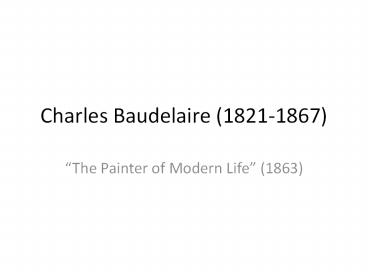Charles Baudelaire (1821-1867) - PowerPoint PPT Presentation
Title:
Charles Baudelaire (1821-1867)
Description:
Charles Baudelaire (1821-1867) The Painter of Modern Life (1863) The idea of beauty which man creates for himself imprints itself on his whole attire ... – PowerPoint PPT presentation
Number of Views:771
Avg rating:3.0/5.0
Title: Charles Baudelaire (1821-1867)
1
Charles Baudelaire (1821-1867)
- The Painter of Modern Life (1863)
2
- Baudelaires most important works of poetry are
the collections - Les Fleurs de mal (The Flowers of Evil), 1857.
- Le spleen de Paris (The Spleen bad temper of
Paris), 1869.
3
- He was also a prolific art critic including the
work we are reading - The Painter of Modern Life
4
- however much we may love general beauty, as it
is expressed by classical poets and artists, we
are no less wrong to neglect particular beauty,
the beauty of circumstance and the sketch of
manners (p.1).
5
- The pleasure which we derive from the
representation of the present is due not only to
the beauty with which it can be invested, but
also to its essential quality of being present
(p.1).
6
Constantin Guys (1802-1892) the painter of
modern life
7
(No Transcript)
8
(No Transcript)
9
- The idea of beauty which man creates for himself
imprints itself on his whole attire, crumples or
stiffens his dress, rounds off or squares his
gesture, and in the long run even ends by subtly
penetrating the very features of his face (2).
10
Edouard Manet (1832-1883), a painter of modern
life and friend of Baudelaire.Baudelaires
Mistress Reclining (1862)
11
- Beauty is made up of an eternal, invariable
element, whose quantity it is excessively
difficult to determine, and of a relative,
circumstantial element, which will be, if you
like, whether severally or all at once, the age,
its fashion, its morals, its emotions (3).
12
Music in the Tuileries, 1862.
13
- The duality of art is a fatal consequence of the
duality of man. Consider, if you will, the
eternally subsisting portion as the soul of art,
and the variable element as its body (3) - cf.
Hegel.
14
Le Bar aux Folies-Bergère 1882.
15
- Constantin Guys is an exemplary artist for
Baudelaire, because of his observation and
immersion in the crowd, and in the life of the
city. - He approaches them as a child approaches the
world, or as a convalescent, after long illness,
re-approaches the world.
16
- The crowd is his element, as the air is that of
birds and water of fishes. His passion and his
profession are to become one flesh with the
crowd. For the perfect flaneur, for the
passionate spectator, it is an immense joy to set
up house in the heart of the multitude, amid the
ebb and flow of movement, in the midst of the
fugitive and the infinite (9).
17
Le déjeuner sur l'herbe, 1862
18
- What is M. G looking for in the crowd?
- He is looking for that quality which you must
allow me to call modernity - By modernity I mean the ephemeral, the
fugitive, the contingent, the half of art whose
other half is the eternal and the immutable
(12).
19
- for any modernity to be worthy of one day
taking its place as antiquity, it is necessary
for the mysterious beauty which human life
accidentally puts into it to be distilled from
it (13).
20
- If a painstaking, scrupulous, but feebly
imaginative artist has to paint a courtesan of
today and takes his inspirationfrom a
courtesan by Titian or Raphael, it is only too
likely that he will produce a work which is
false, ambiguous and obscure. From the study of a
masterpiece of that time and type he will learn
nothing of the bearing, the glance, the smile, or
the living style of one of those creatures whom
the dictionary of fashion has successively
classified under the coarse or playful titles of
doxies, kept women, lorettes, or biches (14).
21
- Titian's Venus of Urbino, 1538-39
22
(No Transcript)
23
- Edouard Manet, Olympia, 1863-65
24
(No Transcript)

